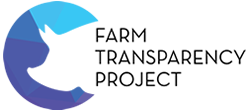News & Media > Editorials > INVASIVE - the story of Australia's unwanted species
INVASIVE - the story of Australia's unwanted species
Each year, around 700 million animals are killed for food in Australia. The vast majority of these are birds, mainly chickens who account for 645 million of all animals killed in slaughterhouses each year. After birds, sheep are killed in the highest number of any land animal in Australia, with almost 30 million killed annually.
Next up are pigs and cows, with around 5.5 million of each killed every year. Approximately 4 million of these pigs are killed in the gas chambers of the country's four largest pig slaughterhouses; Diamond Valley Pork (Victoria), Corowa Abattoir (NSW), Big River Pork (South Australia) and Swickers, Kingaroy (QLD), each able to kill up to 1 million pigs per year. 52% of all cattle killed are slaughtered in QLD, the country's largest cattle farming area.
Then, there are the other animals who are killed and eaten across the country, or whose flesh is transported overseas to be sold in the international market. Many of these animals, such as rabbits, quails, goats, deer and emus, are commercially farmed for their meat, fur, milk or eggs, before they are sent to be slaughtered. But, for hundreds of thousands of other animals who are killed for food every year in Australian slaughterhouses, their lives did not begin on a farm. Their stories began somewhere which seems antithetical to the grim reality of factory farming and commercial animal slaughter; against the background of the much romanticised Australian bush. But it is how these animals are killed, and how we see them as a society before and after their slaughter, that really interests me. Because these aren’t just any wild species. These are animals who have been labelled as many things: introduced species, pests, invasive.
This is the story of these animals.
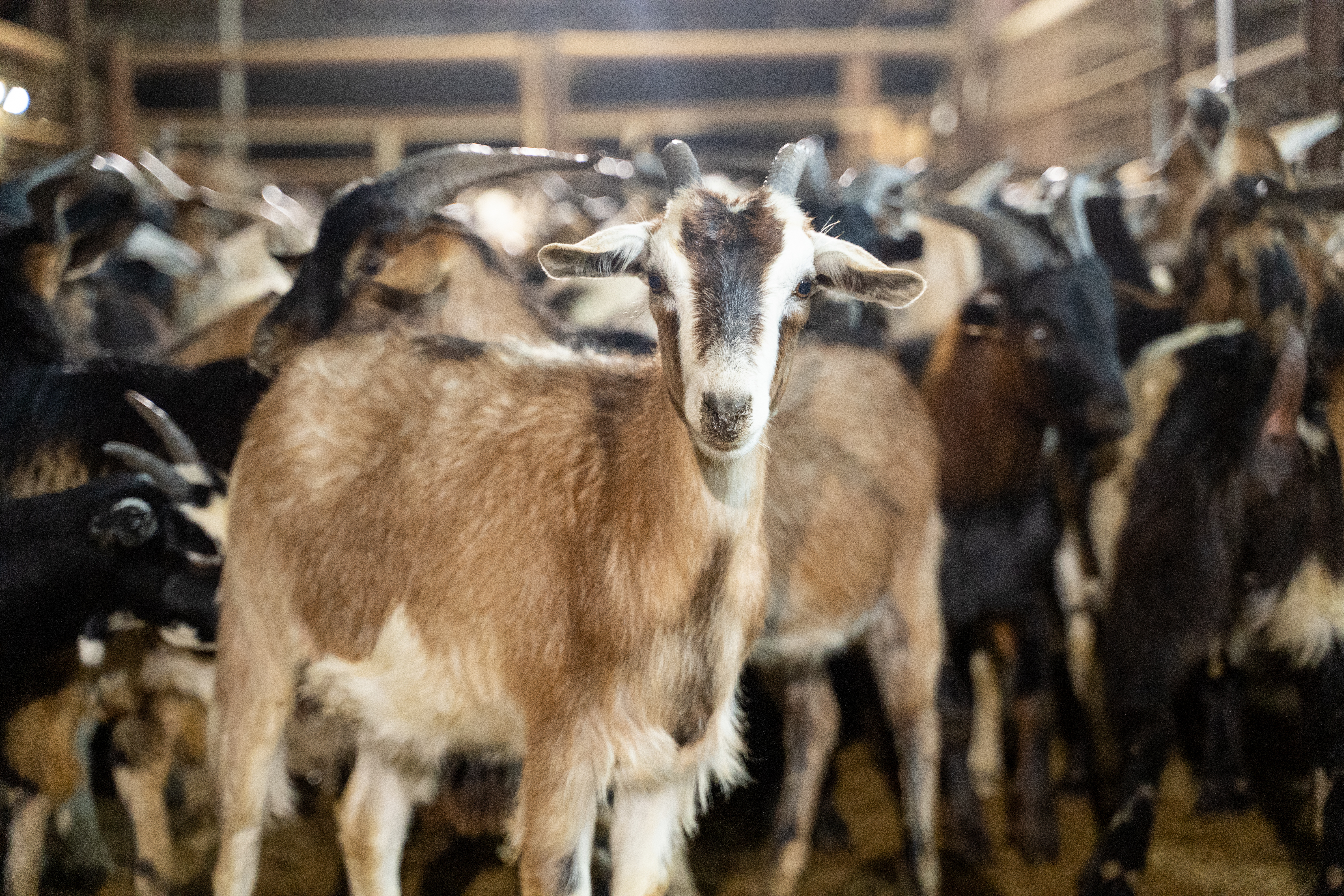
Invasive
Whether we’re talking about human or non-human species, most animals currently alive in the country of Australia, are not indigenous to this continent. When the colonisation of Australia began, between 1788–1901, British invaders intended to supplant the culture and society of Aboriginal Australians with their own, transporting and forcefully introducing their systems of law, governance and, crucially, agriculture.
This physical and social occupation involved the transportation of hundreds of thousands of domestic animals, who were used for food, clothing, labour, entertainment and transport. Many of these animals escaped or were released, establishing wild colonies around the country, which continue to thrive today.
Despite being introduced to this country against their will over 200 years ago, these wild animals are frequently demonised by governments, farmers, the media and the general public. Described as invasive pests, the destructive impacts of animals such as wild goats, horses, camels, pigs and deer is described in detail on government websites, as well as websites such as PestSmart, which is operated by the Centre for Invasive Species Solutions.
Lethal control methods are often passionately defended, with controversial methods including the aerial slaughter of wild horses (brumbies), dog hunting, trapping, shooting, poisons and the deployment of infectious viruses being both legal and endorsed by governments, conservationists and farmers. This mission to eradicate these ‘invaders,’ and the methods used to do so, is a topic of frequent debate and discussion. What is understood far less is that, operating alongside this war on introduced species, is a growing, multimillion dollar industry which profits from and depends on the capture and slaughter of these demonised populations.
Rangeland Goats
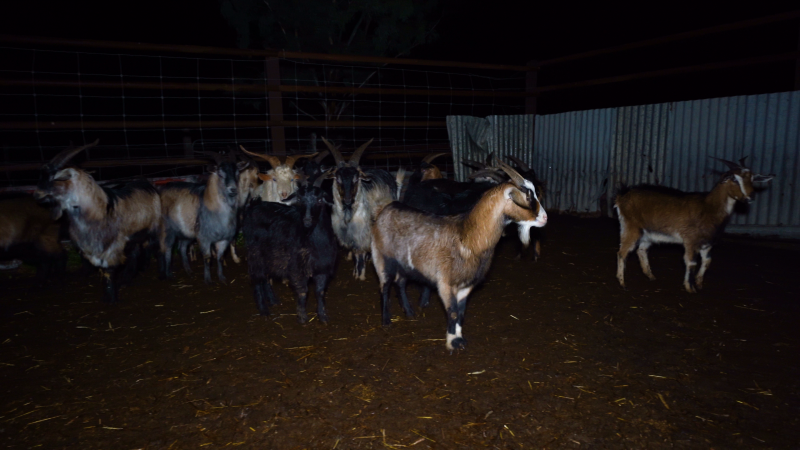
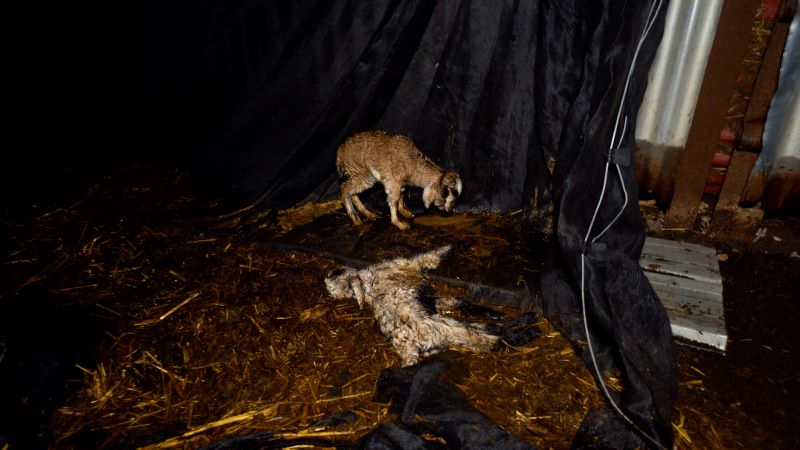
Snowtown Slaughterhouse, 2023 (Farm Transparency Project)
In June, 2023, the Farm Transparency Project team investigated Menzel’s Meats and Snowtown Slaughterhouse in South Australia. Alongside cows, sheep and, in the case of Menzel’s, pigs, both facilities slaughter hundreds of goats every week. These goats were not the short-haired, short-horned farmed goats that are commonly depicted as part of a typical ‘farm’ scene. They were scruffy and bedraggled, with long, multi-coloured hair and intricately curved, wickedly sharp horns. They were flighty, fearful and unquestionably wild.
The footage we captured at these two facilities was to be the first video of the slaughter of wild, rangeland goats which we would document throughout 2023 and 2024, during our investigations of 30 Australian slaughterhouses. Ultimately, we would go on to install hidden cameras inside thirteen facilities which killed these animals, capturing some of the most harrowing and brutal footage of all the 30. Often, we would go into an investigation intending to focus on another species and realising only during the course of installing cameras that hundreds or thousands of the animals being killed were these wild goats, who stood out to us not only because of the frequent violence of their deaths, but because of their fierce determination to resist and fight back against efforts to restrain, cage and ultimately end their lives.
Wild goats were brought to Australia during early colonisation and wild herds are descended from these original goats, as well as others that have been brought over in subsequent years. Rangeland goats are considered a ‘pest’ animal in Australia, with wild herds estimated to cause $25 million worth of losses to farmers every year, due to grazing on land used for farming. Wild populations also damage ecosystems and compete with native animals for food and habitats. Due to their extreme hardiness and wide diet, they are able to survive and flourish in conditions which may devastate native species.
Despite the consistent demonisation of these native populations, the capture and slaughter of wild goats has become a $235m dollar export market, with Australia becoming the #1 global exporter of goat meat.The amount of goat meat exported from Australia doubled in 2023, with 33,891 tonnes being shipped overseas, primarily to the United States, China and South Korea.
Rangeland goats live all over the country, but the majority of herds are found in NSW. In this state, as well as in QLD, and South Australia, large muster stations, known as goat depots, allow musterers to capture goats and ship them directly to slaughter, without having to ear tag them in accordance with the National Livestock Identification System (NLIS). This exemption means that pastoralists can make significant amounts of money selling wild goats to slaughterhouses, without having to invest in the labour and equipment that would be involved in tagging all of these goats, or the land and infrastructure which would be involved in farming them.
The fact that rangeland goats are a significant source of income for many rural farmers, means that alternative, non-lethal population management measures are significantly disincentivised. Additionally, the categorisation of wild populations as ‘pests’ serves the meat and livestock industry well, as it justifies the increasing profit they are making from this often unregulated slaughter.
As wild goats are seen as damaging pests, their capture, transport and killing often falls into something of a legislative blindspot. This is never more apparent than when it comes to the abandonment and slaughter of newborn goats. Many wild goats are pregnant when they are captured, meaning that it is common for newborn kids to be born during transport or in the holding pens at the slaughterhouse. While this happens occasionally with farmed animals (and sometimes intentionally in the case of unborn calves), the nature of wild mustering means that it is far more common for pregnant animals to be sent to slaughter.
During the course of our investigations into Australian slaughterhouses, we documented the handling and killing of these infant animals. Many of them are killed with a bolt gun, which is a legal method of slaughter for farmed animals (including newborn calves and goats) within 24 hours of birth. In welfare standards developed by the Queensland government, it is specified that blunt force trauma must be immediately followed by bleeding out in order to ensure death.
In early 2024, we captured footage of the slaughter of newborn goats at two Victorian slaughterhouses. The first, the Game Meats Company, used a large, pronged, electric stunner to kill newborn goats. Kids would be removed from the holding pens and placed in a plastic bucket for several hours. They would then be electrocuted, often multiple times, in order to cause unconsciousness and death. Afterwards, their throats would be slit. Our footage showed that newborn goats could often be seen continuing to struggle after electroduction and even after their throats had been slit.
At Cedar Meats, one of Victoria’s largest export slaughterhouses, newborn goats were shot with a bolt gun and left to die. Footage showed that on at least two occasions across a two week period, these kids continued to sit up, cry out and attempt to stand for up to 7 hours after having been shot in the head. One goat was captured giving birth while in the stunning restraint. Her throat was slit moments after her baby was born. That baby was taken to a pen and left for nine hours before being shot and killed.
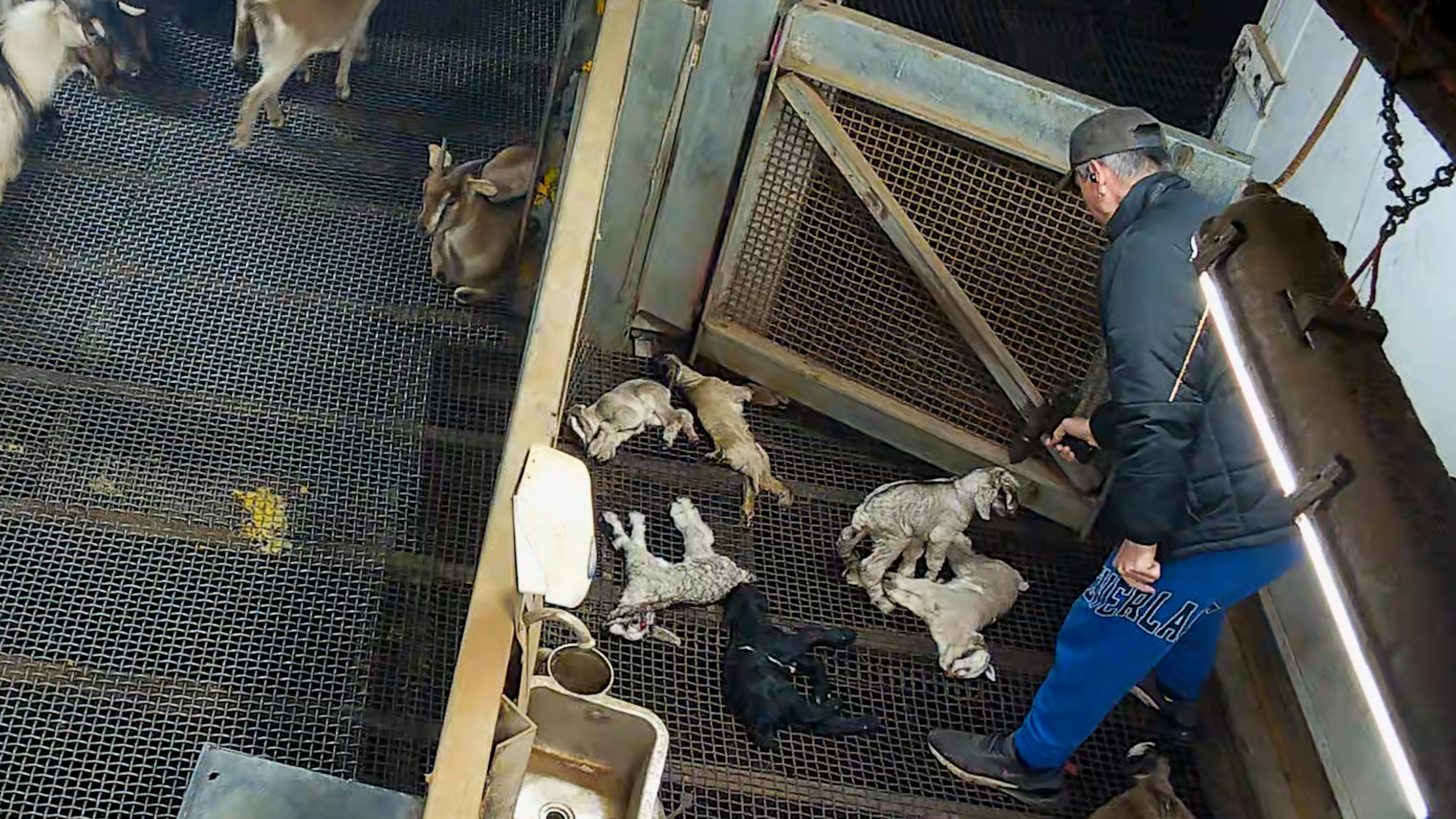
Sanctuaries, including Farm Animal Rescue in Queensland, tell stories of newborn goats being left behind at goat depots, after their mothers have been rounded up and transported to the slaughterhouse. These newborns often starve slowly over the course of days. During the course of our investigations we have also found kids in the holding pens at slaughterhouses, including Snowtown in South Australia, where we rescued a newborn goat who we named Bear. Sadly, Bear, like the majority of these babies, did not make it.
The brutal, often drawn out, deaths of these infant goats demonstrates the carelessness shown to wild born animals, who are on one hand seen as pests and on the other seen as valuable products. While the export market for goat meat is large and growing, governments in Australia are attempting to capitalise further on the slaughter of rangeland goats, investing in research and marketing to increase domestic sales.
Camels
Although commonly associated with countries such as Saudi Arabia and Egypt, Australia is believed to have the largest population of wild camels in the world. These camels are descended from the 10,000 and 20,000 camels who were transported to Australia from India between 1840-1907, largely to be used for labour and transport. In the 1920s, many of these camels were released into the wild as animal labour became less common. Camels now live in most desert areas across Australia, with a 2010 report stating that herds could be found in “50 per cent of Australia's rangelands ecosystems,” including desert areas in Western Australia, South Australia, the Northern Territory Queensland.
While the Northern Territory Government put the number of wild camels at over 1 million, the South Australian Department of Primary Industries cites the much lower number of 300,000. This is indicative of the lack of accurate recording of wild, non-native animals, which advocates argue has led to ‘management decisions’ made on incorrect or misleading information.
Despite being slow to breed and largely living in arid areas which are scarcely populated by humans or other species, camels are classified as a pest by the Australian government, who cite threat of disease transmission to livestock and increased grazing pressure as reasons to justify their capture and slaughter. Common methods used to reduce camel herds are shooting, aerial culling, trapping at water sources and rounding up camels for capture and use in other industries.
Like with goats, camels can be mustered at stations and transported to the slaughterhouse. This is seen as an alternative to culling by some farmers, who have begun to sell wild camels alongside ‘beef’ cows bred on their property. Some farmers also go a step further, feedlotting wild camels before selling them on to maximise profit. Although it is expanding, the camel slaughter industry currently remains small. In 2020, it was estimated that around 5,000 wild camels were being killed for human consumption per year, with meat being sold domestically and exported.
Slaughterhouses including Peterborough Abattoir in South Australia and Wamboden abattoir in the Northern Territory specialise in the slaughter of camels, while others such as Brisbane Valley Meats slaughterhouse kill them alongside other species, including rangeland goats.
As well as being slaughtered for meat domestically, camels are live exported each year for breeding, meat, dairy and tourism. A report prepared by Meat and Livestock Australia (MLA) in 2014 estimated that economic, social and environmental benefits from the live export of camels would be minimal, stating that “modest economic returns and substantial risks limit the attractiveness of investment in Australian live camel exports.” Despite this assessment and these risks, which included concerns regarding animal welfare, the live export of camels has continued with companies specialising in the capture and export of these wild animals.
As well as their meat, wild camels are also captured for the dairy and tourism industry. Although still a small industry, camel dairies have been slowly growing in popularity over the past decade. Between 2014 and today, the number of camel dairies in the country went from one to ten and camel products such as milk and cheese have become more common as speciality items. Camel dairies will often capture and train wild camels as breeding and milking stock, making use of wild herds to grow their business. While camel milk can be sold for high prices, they produce far less milk and breed far slower than dairy cows, meaning that commercial camel dairies may turn to other revenue streams in addition to selling camel products.
Australia’s largest camel dairy and farm, Summerland Camels offers tours, camel rides and a cafe, in addition to selling camel products including milk, cheese, skincare and even camel milk vodka. Just like dairy cows, when camels reach an age where their milk production begins to slow, they are sent to slaughter. For Summerland dairy, this slaughter likely takes place at Brisbane Valley Meats Slaughterhouse in the nearby town of Esk, where in 2024 Farm Transparency Project captured footage of the killing of camels.
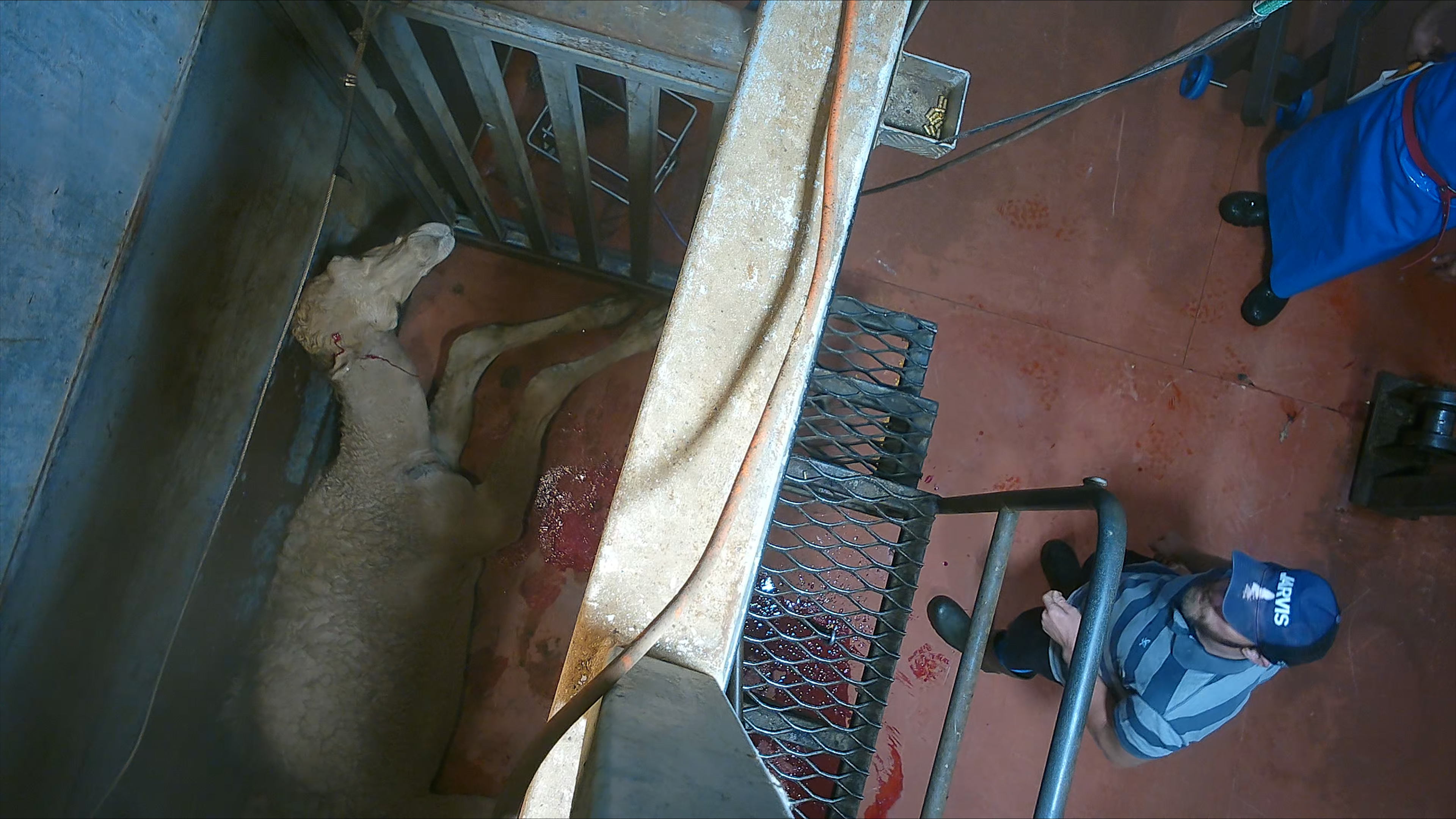
Wild camels are also used for tourism across Australia but particularly in the Northern Territory and Queensland where camel rides, tours and races are popular forms of entertainment for tourists and locals alike. In 2024 Animal Liberation released an investigation showing the treatment of camels at Uluru Camel Tours in the Northern Territory. Footage captured by the group, as well as reports by whistleblowers, showed that camels captured from the wild were routinely and systemically roughly handled, subjected to physical and psychological distress, had surgery and mutilations (including castration and ‘nose pegging’) performed on them without anaesthetic or pain relief and were frequently worked to the point of exhaustion and even death.
Camels' status as invasive ‘pests’ means that individuals, companies and industries which profit from their bodies, products and labour face minimal regulation and oversight. The lives of these camels are considered by many to be forfeit because they were brought to this country against their will, because they don’t belong here and because they had the audacity to manage to survive. Whether they are being shot from helicopters and left to rot or forced to carry tourists on their back day after day, past the point of exhaustion, the exploitation of camels can always be justified as finding innovative uses for a ‘feral resource,’ whose presence is unwanted and whose life is up for grabs.
Water Buffalo

In the 19th century, a small number of water buffalo were brought to Australia as part of an experimental project to provide meat to remote settlements in the Northern Territory. By 1949, these settlements and the buffalo were abandoned, leading to the spread of wild herds across the top end of the Northern Territory which, with its swamps and floodplains offered the perfect environment for the swamp and river dwelling animals.
In the decades that followed, wild buffalo became the focus of targeted eradication campaigns due to their impact on the environment and the potential for them to spread disease to herds of domestic cattle. The largest of these campaigns was the Brucellosis and Tuberculosis Eradication Campaign which used aerial shooting to slaughter wild buffalo en masse. The campaign lasted from 1979 - 1997, killing almost 20,000 buffalo living in Kakadu national park and the northern wetlands in this time.
At the same time as wild buffalo were being clinically and systematically slaughtered however, they were also being captured, killed and sold for multiple purposes including meat for human consumption, pet meat, skin, horns, live export and game for hunters. While remaining small, the buffalo industry has stayed steady over the years, with farmers mustering wild buffalo, or breeding domestic herds for meat and dairy. These industries are seen by some as making use of a ‘wasted resource,’ who would otherwise be culled. Like with goats and camels, the existence of buffalo is seen as a problem with only two possible solutions: to cull or to kill, with the question of who can profit from the death of a buffalo providing the key point of difference.
Like with other ‘invasive’ species, non lethal control measures such as sterilisation and relocation are rarely discussed, and conversations about the need for eradication will often be tempered by arguments to expand industries that depend on these wild herds. These animals are caught in the middle, on one hand a dangerous ecological nightmare and on the other a potential pot of gold allowing producers to make money off animals without having to invest in the infrastructure involved in farming domestic herds.
%20-%20Knockbox%20tipout.00_03_59_03.Still001.jpg)
What is usually missing from these discussions is consideration for the buffalo her/himself. Considered to be naturally docile and easy to domesticate, buffalo are thought to have long memories, particularly for pain and trauma. Their thick skins and large size mean that they have a reputation for being able to “withstand rougher handling than cattle,” but they are also known to be stubborn and to resist mustering and herding in the wild and at the slaughterhouse. Like all introduced species, buffalo were not brought here by choice. They were taken from their homes and transported to a foreign country to be bred and killed for meat and then they were abandoned before being labelled as a dangerous threat to our environment. Their crime is survival and for that they have been sentenced to death.
Conclusion
Whether it’s government programs to incentivise the shooting of foxes, aerial culling of wild horses, the baiting and trapping of wild cats and dogs or the targeting of rabbits with vicious diseases; violence and cruelty is often justified as an appropriate response to control, manage and eradicate introduced species. But, when a price tag is attached to their bodies, the eradication of species classified as ‘invasive’ is far from the end goal.
These animals are herded, corralled, beaten and slaughtered; their bodies turned into products to be sold and their continued existence quietly ensured, even as their killing is justified with cries of conservation and the need to protect native species. Despite this, even native animals aren’t safe from the violence. Over 1.8 million kangaroos are killed each year, their skins sold for leather and their meat turned into pet food or sold for human consumption. This mass killing of native icons, who feed on grassland intended for cattle, accounts for the largest commercial slaughter of wildlife in the world.
The label of invasive is typically applied to species whose existence is a threat to the profitability of animal farming operations, who require enormous amounts of grassland and resources in order to continue operating. It is this same focus on profit that turns the very species that are demonised and maligned by animal slaughter industries into a new source of revenue. The wilds of Australia are not shaped by natural forces; they are carefully controlled by governments and corporations which see all parts of nature - whether animal or plant life - as nothing more than the price tag that can be attached to it.
If we are truly to find a state of balance with our environment, the monopoly on resources claimed by animal agriculture and supported through government payments must end.


